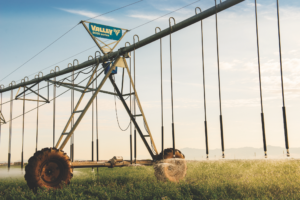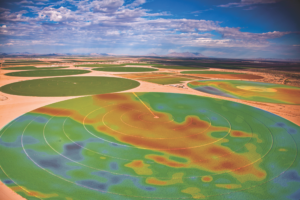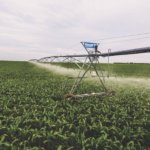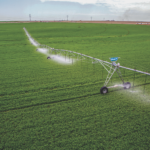Valley Irrigation is a global leader in mechanized irrigation equipment and the industry’s authority on advancing irrigation technologies. Worldwide, Valley irrigates approximately 25 million acres. In addition to conserving water, saving time, reducing input costs and increasing yields, Valley equipment can be remotely controlled from any location in the world.
Innovation is a bedrock principle of the company. In this interview, Irrigation Leader Writer Parker Kenyon speaks with Ashley Anderson, Valley’s product manager for software products, Craig Bell, the company’s production manager for controls and variable rate irrigation, and Chris Righter, the production manager for structure and drive systems, about Valley’s innovative products.
Parker Kenyon: Would you each tell me about your professional background?
Ashley Anderson: My professional background is primarily in product management pertaining to software products, both within the agriculture industry and outside the agriculture industry. I have been doing that for more than 5 years now.
Craig Bell: My background is in website design, user experience design and IT. I was originally involved with the BaseStation product here at Valley on the software development side. Over the last few years, I have transitioned over to electronic controls and variable rate irrigation (VRI). I have been in technology for a little over 10 years.
Chris Righter: The majority of my background has been in manufacturing, about 25 years or so, both in engineering and in product development and support. Specifically, I have been in the ag industry for 21/2years. Previous to that, I was in a variety of other manufacturing industries in engineering, project-management, and business-management roles.
 Parker Kenyon: Would you please give a brief profile of Valley and some of the services that the company provides?
Parker Kenyon: Would you please give a brief profile of Valley and some of the services that the company provides?
Chris Righter: Valley is the global leader in center-pivot and linear irrigation equipment and in smart-irrigation technology. Worldwide, we irrigate about 25 million
acres. People all over the globe use Valley equipment to help conserve water, save time, reduce costs, and improve yields. This goes back to about 1954, when the first center pivots were being patented and produced by Valley. Our parent company, Valmont Industries, of which we are a division, currently has $2.7 billion in net sales, operates on six continents, and has facilities in 23 countries. There are 21 distinct Valmont brands. Valley Irrigation also has a worldwide presence, particularly in South America, Africa, Australia, New Zealand, the Middle East, and Europe.
Parker Kenyon: Would you each highlight some technologies or innovations in your specific product divisions?
Ashley Anderson: Valley is focused on technology from all angles, from software to mechanical and electrical technology. Our recent advances on the software side have been in irrigation scheduling, which helps growers apply water more efficiently. We have recently launched a solution called Valley Scheduling in North America. It is a software platform that ultimately takes a number of measured or modeled data points and uses that information to calculate a specific irrigation recommendation amount for that field.
Parker Kenyon: Is that scheduling service something a farmer can set up on his or her own?
Ashley Anderson: We prefer that they go through their Valley dealer. We can also include their local agronomist, or whomever they are working with on water conservation. That person would be their expert and could provide support in setting up the application, monitoring the data throughout the growing season, and calibrating or adjusting the application to that grower’s needs. The scheduling product provides precise recommendations as to when and where you need the water. That helps avoid over- or underwatering, and helps the grower use water more efficiently. It also helps to increase long-term yield and makes chemical applications more productive by making sure the grower is not washing away chemicals or providing water at the wrong times.
 Craig Bell: On the hardware side, we have the Valley ICON series of control panels, which includes the ICON1, ICON5, ICON10, and ICONX models. Each one has our ICON Link module built into it, which provides cellular telemetry through our AgSense smart irrigation solution. Valley offers a total solution ecosystem for growers. The integration of our hardware and software means that we provide full solution services that allow growers to connect pumps, soil-moisture sensors, pivots, and other irrigation equipment to our cloud-based platform.
Craig Bell: On the hardware side, we have the Valley ICON series of control panels, which includes the ICON1, ICON5, ICON10, and ICONX models. Each one has our ICON Link module built into it, which provides cellular telemetry through our AgSense smart irrigation solution. Valley offers a total solution ecosystem for growers. The integration of our hardware and software means that we provide full solution services that allow growers to connect pumps, soil-moisture sensors, pivots, and other irrigation equipment to our cloud-based platform.
The next thing to talk about is Valley VRI, both on the software and the hardware side. This fall, at all the trade shows, we have been featuring our updated VRI web application, which works with our field-proven VRI-iS hardware that has been available for the last several seasons. Growers can use the Valley VRI software to create prescriptions and send them to the machine via AgSense. Growers can import shape files that they have received from their agronomist or another third party. Valley offers VRI Speed Control and VRI Zone Control, and then we have individual sprinkler (IS) systems, which give the grower individual control of each sprinkler on the machine.
Chris Righter: Valley is not only committed to bringing technology to irrigators but also to advancing the traditional parts of irrigation: the structure and the drivetrain. In 2017, we launched the X-Tec Drive system. This is a revolutionary drive system that is capable of going twice as fast as anything else on the market. We do that by combining a switched-reluctance DC drive with a patented alignment system that uses a proximity switch to continually adjust alignment. This results in laser straightness as the pivot makes its circle. This new development can cut in half the time needed for a pivot to make a circle. A traditional quarter-mile machine, at its fastest speed, normally would take around 8 hours; we have gotten that down to 4 hours with the X-Tec system, depending on tire radius and pivot size.
We are finding technology provides multiple benefits. First, it allows for a greater range in the depth of water that can be put down in a field; as you go faster, you are able to put down smaller amounts of water. Some irrigators use it to cool their crops: In July and August, when you are starting to get those 90- and 100-plus-degree days, irrigators can make a late pass in the afternoon and put down a light amount of water, which brings the temperature of their crops down and can improve crop health. They can also use it to get better precision and control of their chemigation and fertigation when they run it through the pivots. It allows the growers to apply their chemicals in half the time. Growers can use it during the off-season when there are periods of high wind to run a light coating of water to protect their topsoil and hold it in place.
One of the benefits of the DC motor is that it gets full torque, depending on field conditions, at the complete range of speed. From standard speed all the way up to high speed, it continues to apply all the power needed for rough field conditions, slopes, furrows, and mounds. Compare that to competitors’ products that use a standard AC motor and a variable-frequency drive—the issue with those drives is that they see a drop-off in torque as you get to the high and low ends of the speed range. Then they are not capable of handling all the demands and conditions that farm fields can create.
![]() Parker Kenyon: Is the X-Tec Drive system something that a farmer would have to get a completely new pivot to use, or can it be installed on existing pivots?
Parker Kenyon: Is the X-Tec Drive system something that a farmer would have to get a completely new pivot to use, or can it be installed on existing pivots?
Chris Righter: It can be easily retrofitted to existing pivots. Our initial launch was specifically for standard-length pivots. At that time, you would have had to either install a new pivot or retrofit the entire pivot with X-Tec. We have recently released a hybrid technology. As you can imagine, as a pivot is making a circle, the inner towers never have to go as fast as the outer towers. They are not covering as great a distance. We have now released the X-Tec Hybrid configuration, which allows growers to combine their standard motors on the inner towers with X-Tec on the outside towers. It gives them all the speed benefits at a
lower introductory cost. One thing growers won’t get with X-Tec is the start/stop of traditional electric pivot motors: X-Tec is a constant-move machine. Those inner towers remain start/stop, while the outer towers would be constant move. Moving forward, we are looking to move our product to longer machines and also to linear or lateral-move machines.
Parker Kenyon: Would you each please describe your vision for the future of your product area?
Ashley Anderson: From the software standpoint, the future vision is continuing to provide value-added services and working toward a technology ecosystem that benefits growers in more ways than just precision irrigation. By not only incorporating products manufactured by Valley, but by leveraging third-party services and other advances in ag technology, we hope to deliver complete solutions for growers based on their needs.

Craig Bell: From the hardware and VRI side, the main focus is continuing to innovate. I think that is key across all our product areas. We are going to continue to go out and get vast amounts of customer information to make sure that we understand what our growers are asking for and then get that into our development cycle. As a product management and product-development group, we want to make sure that we are providing customers what they ask for, not telling them what they need.
Chris Righter: To echo and expand on that, the structure and drive side is going to continue to track new technological developments in both mechanical and structural engineering so that we can continue to improve and keep the Valley structure the benchmark for the industry. The Valley structure has the reputation around the industry of being the strongest, most durable, and longest lasting. We are going to keep it in that position. We want to apply new technologies and new ideas to ensure that we continue to provide the best value in a pivot to our growers.
Parker Kenyon: What is your message to our readership?
Chris Righter: I think that our message would be that Valley is going to continue to innovate; continue to listen to their needs; and continue to supply products that help them better irrigate to produce higher yields, conserve water, and save time.

For more information, visit Valley Irrigation’s website at valleyirrigation.com.








